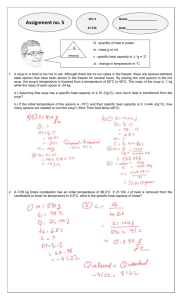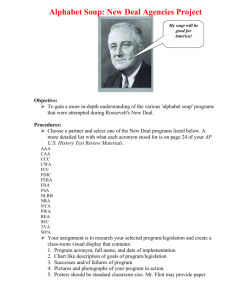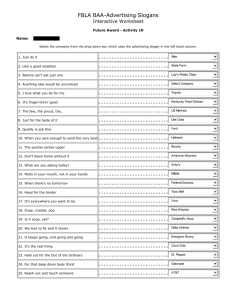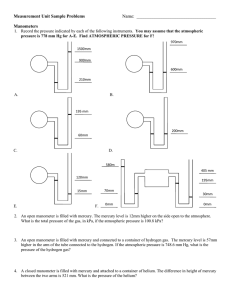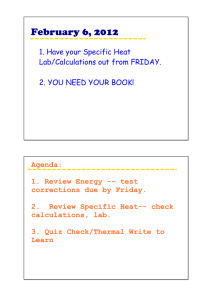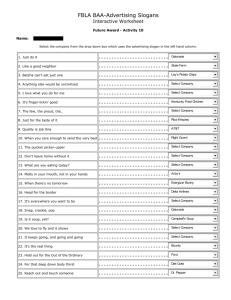Specific Heat Capacity Problems T change in temperature c specific
advertisement
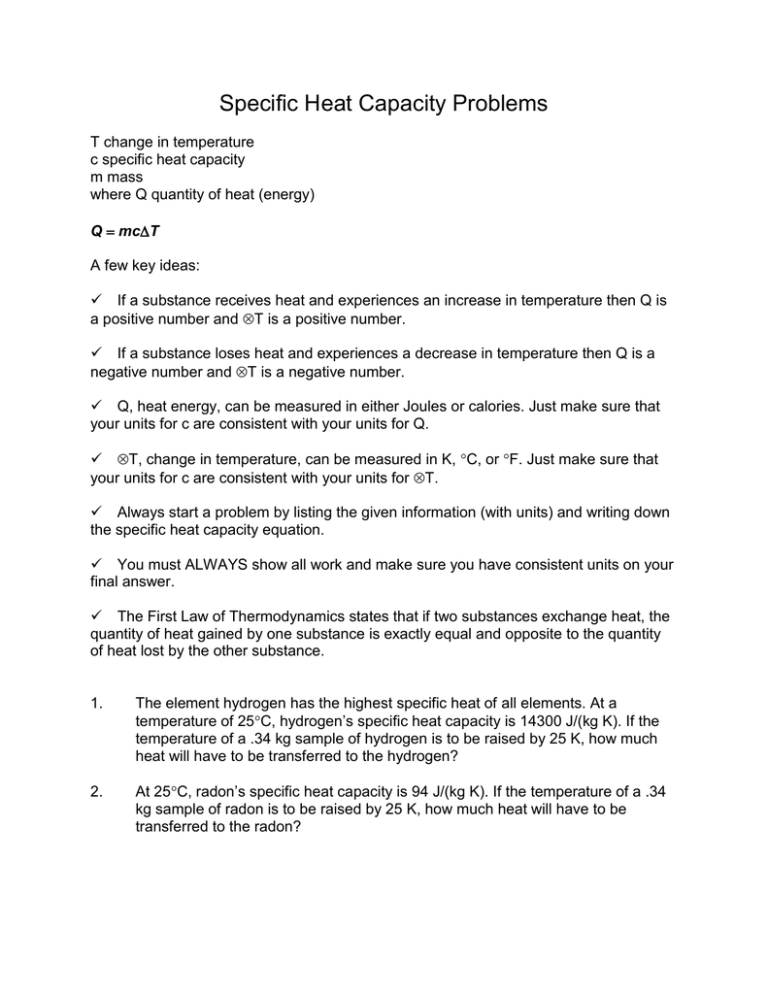
Specific Heat Capacity Problems T change in temperature c specific heat capacity m mass where Q quantity of heat (energy) Q mcT A few key ideas: If a substance receives heat and experiences an increase in temperature then Q is a positive number and T is a positive number. If a substance loses heat and experiences a decrease in temperature then Q is a negative number and T is a negative number. Q, heat energy, can be measured in either Joules or calories. Just make sure that your units for c are consistent with your units for Q. T, change in temperature, can be measured in K, C, or F. Just make sure that your units for c are consistent with your units for T. Always start a problem by listing the given information (with units) and writing down the specific heat capacity equation. You must ALWAYS show all work and make sure you have consistent units on your final answer. The First Law of Thermodynamics states that if two substances exchange heat, the quantity of heat gained by one substance is exactly equal and opposite to the quantity of heat lost by the other substance. 1. The element hydrogen has the highest specific heat of all elements. At a temperature of 25C, hydrogen’s specific heat capacity is 14300 J/(kg K). If the temperature of a .34 kg sample of hydrogen is to be raised by 25 K, how much heat will have to be transferred to the hydrogen? 2. At 25C, radon’s specific heat capacity is 94 J/(kg K). If the temperature of a .34 kg sample of radon is to be raised by 25 K, how much heat will have to be transferred to the radon? 3. A .59 kg brass candlestick has an initial temperature of 98.0C. If 21,100J of heat is removed from the candlestick to lower its temperature to 6.8C, what is the specific heat capacity of brass? 4. Mercury has one of the lowest specific heat capacities. If 257J of heat are added to .45 kg of mercury, the mercury’s temperature will increase by 4.09K. What is the specific heat capacity of mercury? 5. A .38kg drinking glass is filled with a hot liquid. The liquid transfers 7032J of heat to the glass. If the temperature of the glass increases by 22K, what is the specific heat capacity of the glass? 6. The temperature of air in a foundry increases when molten metals cool and solidify. Suppose 9900000J of heat is added to the surrounding air by the solidifying metal. The air’s temperature increases by 55K, and the air has a specific heat capacity of 1000J/(kg K) What is the mass of the heated air? 7. The temperature of the air above coastal areas is greatly influenced by the large specific heat capacity of water. The specific heat of air between temperature of 40F and 90F is about 1000J/(kg K) . Consider the situation where 4186J of heat is given up by 1kg of water causing its temperature to drop by 1.0K. If the air over the water increases temperature by 5.5K, what is its mass? 8. A .225kg sample of tin, which has a specific heat capacity of 2300J/(kg K) is cooled in water. The amount of heat transferred to the water is 3900J. If the final temperature of the tin is 18C, what was the initial temperature? (Hint: Find the change in temperature first.) 9. Tantalum is an element that is used in aircraft parts. Tantalum has a specific heat capacity of about 140J/(kg K). The aircraft part has a mass of .23kg and is cooled from a temperature of 1200K by being placed in water. If 30000J of heat is transferred to the water, what is the final temperature of the part? 10. The soup in a bowl is too hot to eat. Although there are no ice cubes in the freezer, there are several stainless steel spoons that have been stored in the freezer for several hours. By placing the cold spoons in the hot soup, the soup’s temperature is lowered from a temperature of 82C to 48C. The mass of the soup is .1kg while the mass of each spoon is .04kg. a.) Assuming that soup has a specific heat capacity of 4186J/(kgC), how much heat is transferred from the soup? b.) If the initial temperature of the spoons is -15C and their specific heat capacity is 448J/(kgC), how many spoons are needed to cool the soup? (Hint: Their final temp=48C)
